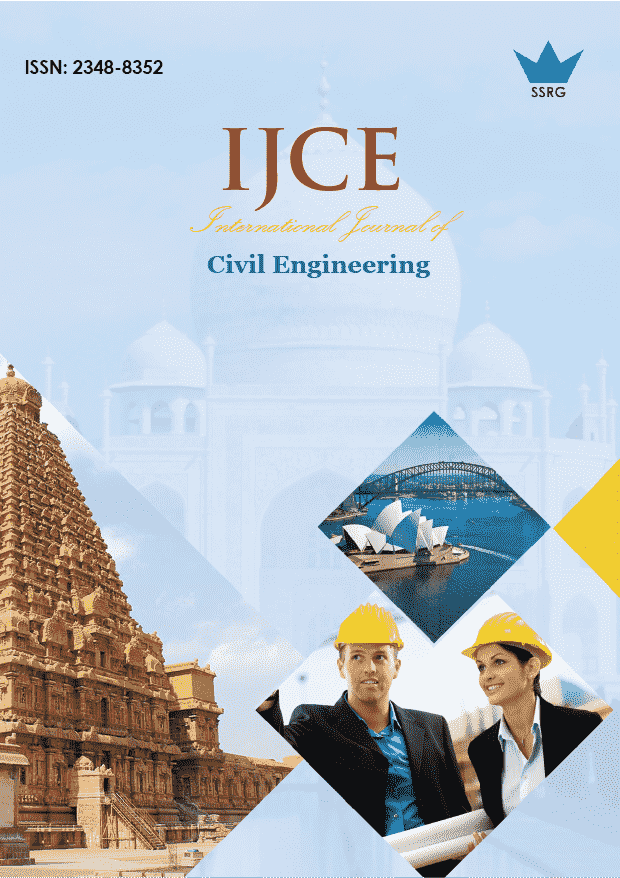Economic Design of Combined Gravity and Pumped Water Transmission Main

| International Journal of Civil Engineering |
| © 2025 by SSRG - IJCE Journal |
| Volume 12 Issue 3 |
| Year of Publication : 2025 |
| Authors : Madhulika Sargaonkar, Laxmi Gangwani, Satyam Tiwari, Nikita Palod, Rajesh Gupta |
How to Cite?
Madhulika Sargaonkar, Laxmi Gangwani, Satyam Tiwari, Nikita Palod, Rajesh Gupta, "Economic Design of Combined Gravity and Pumped Water Transmission Main," SSRG International Journal of Civil Engineering, vol. 12, no. 3, pp. 176-184, 2025. Crossref, https://doi.org/10.14445/23488352/IJCE-V12I3P116
Abstract:
A water transmission system is designed to supply treated water from the Water Treatment Plant (WTP) to the storage reservoirs located in the city's different zones in urban areas or different villages in a grouped water supply scheme. In the case of a grouped water supply scheme, the cost of the transmission network is quite high as the villages are generally located far from each other. Such a transmission system is planned as a direct pumping or a combined gravity and pumped type system. Recently, in the CPHEEO Manual, a methodology for the economic design of such systems is suggested that involves minimizing the cost of pipes, cost of pumps, Master Balancing Reservoir (MBR) cost (if required), and capitalized energy cost. A Linear Programming (LP) based model is suggested to design the network. The LP model provides two pipe sizes for some of the links, which is sometimes not favored by field engineers. Herein, a methodology based on a single pipe size for each link called the Modified Marginal Cost Increase Head Gain Ratio (MMCH) method, is suggested. The present work focuses on developing software using Python code. Initially, it is tested with a single-source, single-destination pumped transmission main, which is used to pump water from the sump of a WTP to MBR. Later, an economic analysis of a combined gravity and pumped transmission network is considered. The example network from the manual is considered, and it is observed that the overall difference in cost is 1.04 % when each link consists of a single size in the transmission network.
Keywords:
Transmission system, Pumped transmission main, MMCH method.
References:
[1] Prabhata K. Swamee, “Design of Multistage Pumping Main,” Journal of Transportation Engineering, vol. 122, no. 1, pp. 1-4, 1996.
[CrossRef] [Google Scholar] [Publisher Link]
[2] P.S. Mahar, and R.P. Singh, “Optimal Design of Pumping Mains Considering Pump Characteristics,” Journal of Pipeline Systems Engineering and Practice, vol. 5, no. 1, 2014.
[CrossRef] [Google Scholar] [Publisher Link]
[3] Nikhil Hooda, and Om Damani, “JalTantra: A System for the Design and Optimization of Rural Piped Water Networks,” INFORMS Journal on Applied Analytics, vol. 49, no. 6, pp. 397-459, 2019.
[CrossRef] [Google Scholar] [Publisher Link]
[4] Prathmesh Rajendra Patil, and Pooja Gopal Gandhi, “Optimal Design of Water Transmission System,” International Research Journal of Engineering and Technology, vol. 7, no. 5, pp. 2417-2420, 2421.
[Google Scholar] [Publisher Link]
[5] Gebremedhin Mulatu Gessa, “Evaluation of Methodologies for Determination of Economical Pipe Diameter of Water Pumping Mains,” International Research Journal of Engineering and Technology, vol. 8, no. 2, pp. 1173-1176, 2021.
[Publisher Link]
[6] Maharashtra Jeevan Pradhikaran, “State Schedule of Rates for the Year 2023-24,” Report, 2023.
[Publisher Link]
[7] Government of India, Ministry of Housing and Urban Affairs, “Manual on Water Supply and Treatment Systems (Drink from Tap,” Report, pp. 1-1283, 2024.
[Publisher Link]
[8] Vijendra Kumar, and S.M. Yadav, “State-of-the-Art Review of Heuristic and Metaheuristic Optimization Techniques in Water Resource Management,” Water Supply, vol. 22, no. 4, pp. 3702-3723, 2022.
[CrossRef] [Google Scholar] [Publisher Link]
[9] Ioan Sarbu, “Optimization of Urban Water Distribution Networks Using Deterministic and Heuristic Techniques: A Comprehensive Review,” Journal of Pipeline Systems Engineering and Practice, vol. 12, no. 4, 2021.
[CrossRef] [Google Scholar] [Publisher Link]

 10.14445/23488352/IJCE-V12I3P116
10.14445/23488352/IJCE-V12I3P116